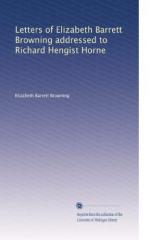|
This section contains 4,322 words (approx. 15 pages at 300 words per page) |

|
SOURCE: Olivero, Federico, “On R. H. Horne's Orion.” Modern Language Notes 30, no. 2 (February 1915): 33-39.
In the following essay, Olivero comments on Horne's dynamic style in Orion, especially noting its contrast against Keats's notoriously whimsical poetry.
Horne's Orion is one of the best instances to show how Keats's allegoric way of handling a Greek fable was intimately responsive to the æsthetic ideals of an age fond of a kind of poetry which might adorn subtle, metaphysic conceptions with the radiance of a sumptuous imagery. Keats tried to express the passion and mystery of life by means of symbols derived from an Hellenic legend, and Horne used the same artifice to manifest his theories; the latter, however, goes even farther on this philosophic track, and we find in him a strong tendency to transcendentalism. Allowing for the difference of race and genius, we may say that Horne's method when composing...
|
This section contains 4,322 words (approx. 15 pages at 300 words per page) |

|


